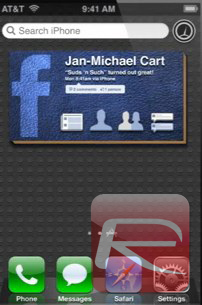Two weeks ago, we reported on a user interface concept by Jan-Michael Cart for a great implementation of speech recognition on the iPhone. Now he’s back at it with a concept for implementing widgets into iOS, a feature that can already be found in Android and Mac OS X.
This concept proposes replacing the spotlight screen, which is currently used for searching. While the search box would still be there, an additional button would be created to add widgets, such as Facebook, from a pre-populated list. Widgets would be placed in "home screens", just like apps, except app screens would be placed to the right of the spotlight screen, while widget screens would be placed to the left. When the search box is in use, the widgets on the spotlight screen would automatically hide so search results could be displayed, much like what happens in the current version of iOS. Widgets would presumably be downloadable from Apple’s own app store, or included with Apps themselves.
Jan-Michael Cart has published another widget concept in the past. The main difference between it and the new one is that the former would allow widgets to be moved to app screens. That’s no longer the case with the new concept.
I think it’s legitimate to ask whether widgets are worth the effort or not. Widgets are essentially applications running in the background, using up processing power, batter life and data from a possibly already pricey data plan. There would have to be a way to manage those widgets in a way that it wouldn’t put so much of a strain on the phone’s hardware on the cellphone bill, and that at the same time would preserve user-friendliness. In addition, launching an app whenever its needed might turn out to be more efficient than having to scroll across different home screens just to access the desired widget.
Either way, this concept brings up a good point: there’s still work to be done on iOS as far as notifications and integration with web services are concerned. Whether we’ll need to go down Android’s route and implement widgets will be up in the air, but we’ll need more than the same old push and badge notifications.
(Thanks to Jan-Michael Cart for referring the video to us)
You can follow us on Twitter or join our Facebook fanpage to keep yourself updated on all the latest from Microsoft, Google and Apple

